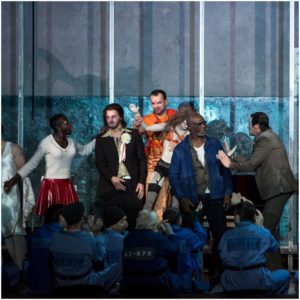
La Monnaie De Munt 2018-19 Review: From the House of the Dead
Janáček’s Masterful Music Overcomes Staging Oddities
By Santosh VenkataramanMuch has been said about Polish director Krzysztof Warlikowski’s production of Leos Janáček’s “From the House of the Dead (Z mrtvého domu)” that was recently seen at the Royal Opera House. OperaWire’s review from that series of performances was titled “Prison Drama Locks Up Its Singers” in reference to the directs subversive and interruptive choices throughout.
And now, the controversial production has now made its way to La Monnaie in Brussels as part of its co-production along with Opéra de Lyon.
The composer’s final opera was completed two years after his death when it debuted in Czechoslovakia in 1930. This edition was based on a score generated with the aid of British musicologist John Tyrrell with Sir Charles Mackerras; Tyrrell was a noted Janáček scholar who passed away just last month.
The work is based on Fyodor Dostoyevsky’s novel, “The House of the Dead,” that was about the critical period in the Russian author’s life in which he was imprisoned in Siberia. The genius of the book was how Dostoyevsky peered inside the minds of those within the operation from prisoners to prison guards all while using no clear narrative.
Fighting Against One Another
Warlikowski transposes the setting to a more modern one that resembles what could be an American prison; the opening features a prisoner shooting on a basketball court before the first note of music. This idea certainly worked as an overall concept in demonstrating the relevancy of the issue in modern times and particularly in the United States, known for the highest incarceration rates. Of course, this decision was risky since took the Russian character out of an opera that is so infused with it.
What unfolded, unfortunately, was not a performance that worked seamlessly between the music, the singing and the staging but rather against one another. Warlikowski’s ideas have merit but they created a feel to the proceedings of one performance going on in the pit and something completely different taking place on stage.
Unpacking The Mess
One could have listened to the music on hand and come away thoroughly satisfied, although that fulfillment was diminished by how this was staged and how the singers were used. In fairness, this is a work designed for singers to shine as an ensemble rather than as individuals. At the same time, they were often put in unusual positions.
For example, in Act one, Gorjančikov is brought into the prison in a cage-like structure on the left side of the stage while the basketball court is on the right side with numerous prisoners clad in red and blue, both on the stage and on makeshift bleachers along the side.
Bass-baritone Sir Willard White, who portrayed Gorjančikov, is behind bars on the left side that obscure his singing about his flogging. Meanwhile, the actions of the prisoners on the basketball court divert the viewer’s attention and the whole affair feels somewhat disjointed.
That omnipresent jail cell similarly shackles many of the other singers since it is a constant throughout the opera. Another touch by Warlikowski is a movie screen in between acts that feature conversations by actual prisoners about prison life as well as a video of French philosopher Michel Foucault speaking on the subject; these indulgences brought very little to the work as a whole.
Should the Voice Be Heard?
Much credit goes to the singers for performing under such strange conditions. That is especially the case because this opera has so many characters and the way it was staged often made it difficult to even discern who was singing.
The Czech tenor Ladislav Elgr shined in his role as Skuratov in which he dominates Act two as he relates the story of how he murdered the groom of a German girl he was in love with; Skuratov is analogous to the Baklushkin character from Dostoyevsky’s book.
Elgr sang with hostility and force; the problem was that what was depicted on stage was perhaps the least inspiring part of the production. The character’s reenactment of his murders was performed in a “play within a play” with the other prisoners as the audience. A scene that featured one of the highlights of this work somehow lost its dramatic effect.
Bass-baritone Pavlo Hunka as Šiškov and tenor Stefan Margita as Luka Kuzmic brought similar menace to their roles as did Elgr, while tenor Pascal Charbonneau was mysterious in his part as Aljeja.
Yet unlike with Dostoyevsky’s prose and Janáček’s music, the way the drama unfolds offers no clear view of any redemptive qualities of these characters; they seemed more like actors executing their jobs than prisoners with true humanistic qualities.
The Star of the Show
The biggest reason to take in “From the House of the Dead” is to experience the sumptuous music of the composer. In what may be Janáček’s finest opera, his music is alternatively glorious and haunting, melodious and meandering, captivating and sonorous.
Conductor Michael Boder and the La Monnaie Symphonic Orchestra produced a display faithful to what this music intended in creating an overall picture and shunning nuance.
Musical extravagance was avoided with a reduced focus on any experimentation. A feeling of dread was conveyed yet also a sense of some underlying pangs of hope, which is central to the themes of the book and Janáček’s score.
“From the House of the Dead” is a crucial work as a showcase of Janáček’s brilliance. Other approaches to staging it will undoubtedly be more illuminating.
Yet given that productions of it are few and far between, this one was still worth seeing despite some glaring limitations.


